Gain Greater ROI with the Facebook Ad Templates Starter Pack
This is because Facebook can aid the upper levels of your marketing funnel: Search is where customers look for you but Facebook is an ideal way to find potential customers and widen that audience base.
Welcome to Paid Traffic’s Facebook advertising starter pack.
Facebook is the most powerful paid social platform available and it allows you to gain a better ROI and access an audience beyond SEM.
This is because Facebook can aid the upper levels of your marketing funnel: Search is where customers look for you but Facebook is an ideal way to find potential customers and widen that audience base.
In this exclusive starter pack, you will learn why Facebook should be an essential part of your marketing portfolio, you will gain access to 3 Facebook ad templates for top performing ads and learn how to build a simple Facebook campaign.

Why is Facebook so powerful?
Facebook has an immense audience, sophisticated persona targeting, boasts high conversion rates and low CPC compared with paid search and has a wide range of ad types.
Audience: With roughly 1.5 billion people using the platform regularly, it has a greater market reach than any other social media site.
Targeting: When it comes to building audience personas and reaching those users, Facebook is the champion. You can target by age, gender, location, income, hobbies, jobs, likes, dislikes, fashion sense and a host of other interests.
High CVR: The current average conversion rate of Facebook is 9.21%, yet the median conversion rate on AdWords is only 2.35%, with the top 25% of accounts still only looking at roughly a 5.31% conversion rate.
Low CPC: While costs have increased, as more advertisers take advantage of Facebook, it still has a relatively low CPC across many industries with an average of just $1.72 US dollars.
Various ad types: This variety can help you craft the right campaign with innovative creatives and formats to suit your needs.
The many ad styles can leave new advertisers overwhelmed. To gain a great ROI you want to avoid wasting time by guessing and making mistakes with your ads. To help you develop winning ads quickly, Paid Traffic have put together 3 actionable Facebook ad templates to get you started. By following the structure and advice in our templates, you can start building beautiful, effective Facebook ads today.
Ad Type 1 – Multi-link carousel ads
Let’s start with a simple ad style that really works. A multi-link carousel ad is an excellent creative improvement on a standard Facebook link ad.
You have probably encountered standard link ads if you have ever accessed Facebook as a user. All ads are identifiable by the ‘sponsored’ label.
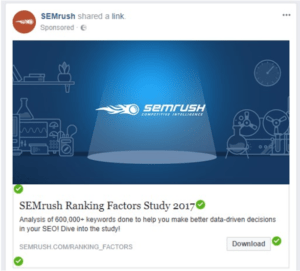
Standard link ads usually consist of main ad text, a headline, link, link description, image and call to action button.
While standard link ad campaigns can be successful, they are now a common sight on Facebook. Users are more familiar with and likely to ignore a standard ad, due to ad blindness. The ads are also somewhat limited in what they can present to a user in the short character limit.
A multi-link carousel ad is far more versatile. You can have a selection of scrollable imagery and multiple link destinations as well.
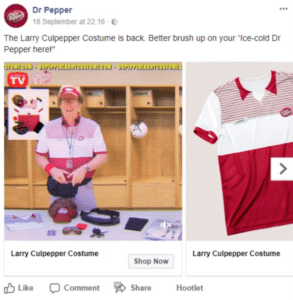
Why is this ad style a winner?
Advertisers are using carousel ads in a variety of ways to attract users. Some use multiple images to enhance the one product/service offering. This is useful if you have a highly visual product or want to demonstrate its varied functionality.
Others have used the multi-link aspect to highlight a range of products or services in one ad. This ability makes carousel ads particularly useful for e-commerce businesses looking to add more scale and efficiency.
An additional benefit is that they are slightly larger and more prominent in the newsfeed and their interactive scrolling is entertaining for users.
Your Carousel Ad Template
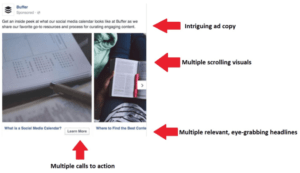
You can see from the template that carousel ads offer a lot of scope for experimentation. You can convey a selection of related messages to your audience simultaneously with the CTAs, links, images and various headlines in your carousel.
Variety is clearly an advantage, however, to ensure this ad template delivers you a good ROI you need to be strategic.
Apply these pro tips to the template above and you will have a winning ad on your hands:
How to make carousel ads work for you
- Make sure your main ad copy is attention grabbing but also relevant. Writing compelling ad copy is always hard work and with carousel ads you have another thing to worry about.
If you have opted to display multiple products or services in your links, you need to make sure your primary ad copy is consistent for all of them. If it applies to one link and not the others your ad won’t make sense and will offer a poor user experience.
This template is a fitting example to guide you, since the main ad copy works seamlessly with each link. Buffer are promoting their social media calendar tool and offering users a peek inside its functionality. To do this they are sharing multiple resources for each of its different features, so each dynamic headline compliments the main ad copy.
If you’re struggling with writing interesting copy, try asking a question. This is usually more effective on social than in search because people are looking to chat and share opinions, therefore by asking users a direct question that sounds genuine and non spammy you can engage their vanity long enough to grab their attention.
- Keep headlines succinct. The carousel has many advantages, yet it does make the space for your headlines more cramped. You can leverage multiple headlines but to retain their impact and readability you need to keep them short and to the point. Save a longer explanation for the main ad text above the images.
- Always use related products with multi-links. Choose related products or products from the same category to keep your main ad copy relevant and your targeting more precise.
- Think outside the box. Businesses have been seeing great returns by taking carousel ads to creative new heights. Some are using the multiple images feature to create one large flowing image or to tell a story.
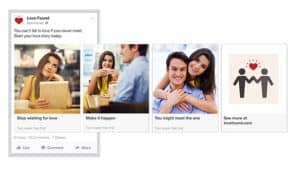
This is a clever way to capitalise on the interactive element of the ads to boost user curiosity and ad engagement.
How to create your own Facebook campaign with a multi-link carousel ad
Step 1. From the Facebook newsfeed, select the drop down at the top right corner of the screen next to your notifications and quick help section. Now select create adverts.

Step 2. In Ads Manager select create ad. You can then select your campaign objective.
Multi-links ads work well with many objectives, so think carefully about the purpose of your campaign before selecting.
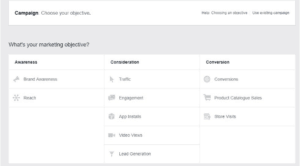
Step 3. Give your campaign a memorable name for your records.
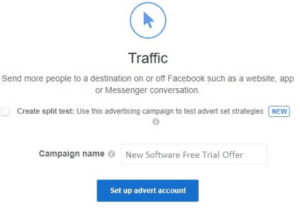
Step 4. If it is your first campaign on Facebook you will be prompted to set up your billing information and general settings. Ensure you enter the correct time zone and currency for your account.
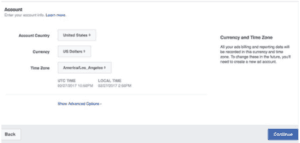
Step 5. Choose the associated Facebook page for your campaign.

Step 6. Set your audience targeting. In addition to demographics and interests you can create custom audiences for remarketing and from email lists.
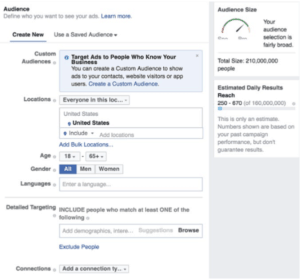
Step 7. Set your placements, budget and schedule. Facebook automatic placements are best for maximum coverage. When it comes to your bidding strategy, double check how you wish to be charged. Some objectives offer no choice on how you are charged but for others you can choose to be charged by impression or clicks. On certain objectives you can also alter what campaigns are optimised for e.g. link clicks, daily unique views, landing page reach etc.
You can set an optional max CPC, a daily budget, as well as the overall spend limit for the campaign and run your ad continuously or set start and end dates.

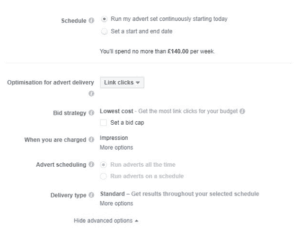
Step 8. Now you can finally choose your ad creatives. Enter your main text copy and a main URL. You have the option of whether to optimise the best performing image and to add a finishing card with your business logo.
Now toggle between the numbers for your various images and links. Three are shown but you can click the + symbol to add up to ten. Each number is a slot where you can add a unique visual, link, headline, link description and call to action.
Facebook recently added the option to use videos instead of images in the carousel for an even more visually dramatic ad but this is not available in all countries yet.
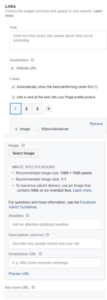
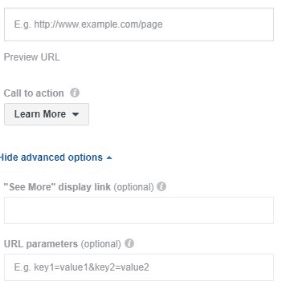
Specs
Your main text can be 90 characters. Your image should be 1080 x 1080 and will be a 1:1 ratio.
Text within images must be less than 20% to avoid being penalised and disapproved. Your headline can be 40 characters and your link description 20 characters.
You have a set choice of calls to action, including learn more, shop now, book travel, watch more, download, sign up, use app and open link.
Once creatives are complete, you can review them for different screens and then order your ads. Having been approved your ads will go live.
Template 2 – Video ads
The explosion of video on Facebook cannot be overstated. Facebook video views have seen an astonishing 100% growth over 6 months.
Video is doing particularly well since Facebook are keen to push this medium, as they look to take on YouTube as a primary online video service.
Thanks to this, videos have increased 360% across the public’s newsfeeds, hence video ads can be highly effective and lucrative.
Why is this ad style a winner?
Video is notoriously successful at creating emotive reactions in people. As visual beings we find this format compelling. Recent research shows 4x as many customers would rather watch a video about a product than read about it, so you would be remiss to ignore the potential of video ads.
Video ads also provide a practical advantage, as you can say and/or show a great deal more in a short video than you can with text, due to the character limit. This ad style is especially useful for B2B and more expensive items where users will need to know more information.
There is also great news for the future of video on Facebook. Video is being applied within various other ad types. You can now have standard video ads, video carousels, video lead generation ads and more.
Your Video Ad Template
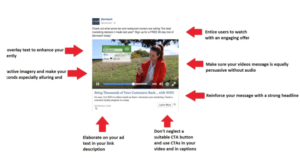
How to make video ads work for you
- Consider length carefully. Facebook allows more choice in terms of video ad length than YouTube. You can go on for over an hour if you really want to but it might not be the best tactic for high ROI. While most advertisers opt for 1 – 2 minutes, statistically 15 – 30 seconds are the best performers. Short and sweet is best for views but if you’re looking for highly qualified leads or conversions, a little more depth could work to your advantage. If you want to go for longer video, why not use short video ads to promote other longer content like a Facebook live video webinar event.
- Don’t neglect your text copy. Using video doesn’t diminish the importance of your text copy. Videos play silently in Facebook until clicked, so you need that opening text pitch to be really convincing.
- Choose dynamic thumbnails and opening visuals. Your thumbnail image and the first 10 seconds of video are the most important visually. These will determine if users are interested enough to click and watch with audio. While human actors can be helpful, try using something more unusual in your opening image. Movement and bright colours are often successful.
- Make your message work without sound. If your message can be conveyed both audibly and in silent video, it will perform better. Some users don’t want sound to play on their devices while they browse Facebook, for various reasons, so don’t rely on audio. Include text within your videos to solve the issue. You can do this by adding captions in Ads Manager.
- Try slideshows. If you don’t have the budget or time to make a complex video don’t abandon video ads. You can turn a series of still images into a video with the slideshow option.
- Convey your point quickly. Get to the point and highlight benefits fast to ensure your message is heard before impatient users keep scrolling.
- Use CTAs. Calls to action guide users and you can use these in your audio script, in your captions and in your CTA button.
- Consider your objective and charging options. Historically, you had to choose video views as your objective and be charged by impression. This is no longer the case as video roles out to be incorporated in carousel ads and in other ad formats. You could run a traffic campaign and be charged CPC if it serves your goals better. Bear in mind CPM is needed for auto play and this is a big advantage for grabbing user attention.
How to create a Facebook video ad
Step 1. Follow the campaign creation instructions from template 1.
Step 2. Having completed your targeting, budget and schedule options, it is time to create your ad. Choose single video, slideshow or carousel.
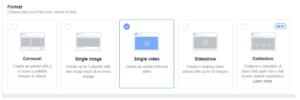
Step 3. Upload your video
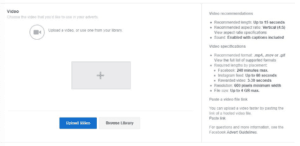
Step 4. Choose your thumbnail and set your captions by uploading a SRT file.

Step 5. Add your destination URL, text ad copy, headline, link description and a CTA button.
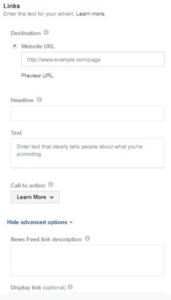
Always preview your ads, especially with videos, to see captions are working correctly and then you are ready to rake in those customers.
Specs
Text aspects are the same as standard ads.
Your video can be a max of 120 minutes.
File size allowed is up to 4GB.
The best video formats are .MOV or .MP4 files.
Template 3 – Lead Generation Ads
Lead generation ads are highly underrated. Business owners often make the mistake of assuming they are only suitable for lead generation business models. In reality these ads have a huge amount of scope.
Virtually any industry can use them to great effect for pushing users further down their conversion funnel, even small e-commerce companies will find them valuable.
Whether you’re looking to gain highly qualified leads or just expand your email marketing lists and brand awareness, these ads have some distinct advantages.
Why is this ad style a winner?
Advertisers big and small from across the world have found lead generation ads to be especially profitable thanks to their flexibility, customisation options and because the user never needs to leave Facebook.
Creative flexibility – The actual visual of the ad can be a standard image, a carousel style ad or even a video. It is the lead generation form that makes it distinct from other ads. This means you can really make the ad your own and incorporate strengths from other ad styles you have found most successful.
Customisation – The lead generation forms can be customised to suit your business needs. You can collect an array of information e.g. phone numbers, company names, location, relationship status etc and you can even ask users 3 more in-depth questions. There is, therefore, a massive opportunity for data acquisition and future campaign tailoring around audience desire.
Users don’t need to leave the platform – These lead generation ads cleverly avoid one of Facebook’s biggest flaws. Users on Facebook are higher up the funnel compared to search. They are primarily on Facebook to socialise and for entertainment. This means advertising campaigns based on tempting them off the platform to your website are weaker than in other environments. Lead generation ads circumvent the problem by acquiring leads from within the platform.
Best of all, the form self populates with the user’s profile information. The user can simply hit submit and you can market to them. This greatly lessens the apprehension and reluctance some people have when confronted with forms. You can then easily export your leads or sync up Facebook with your CRM tool for greater efficiency.
Your Lead Generation Ad Template
Part 1:
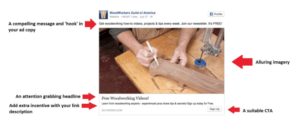
Part 2:
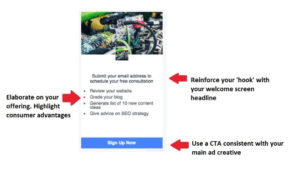
Part 3:
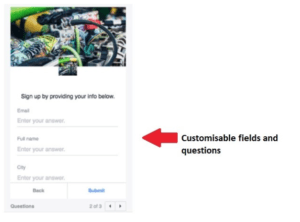
Part 4:
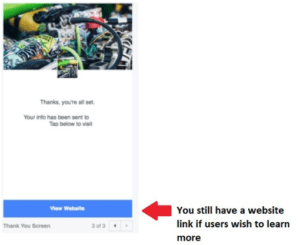
The primary visual experience is identical to any simple link or video or carousel ad.
When a user clicks, instead of heading to your website, a form appears with an optional welcome screen or ‘context card’. If they click the CTA or if there is no welcome screen, they are show the fields of your form. This will auto populate and then the user can either submit or correct this. Leads are stored within your Ads Manager for you to download as needed.
If users become a lead, they are presented with a Thank you screen.

How to make lead generation ads work for you
- Offer an incentive. Users are unlikely to want to give you their details for marketing. Even your ideal customer may be worn down by marketing campaigns. You need to tempt them with something worthwhile. Think about what would be useful to your target audience and offer them a discount, a coupon, a prize draw, a whitepaper or a free trial.
- Use the optional welcome screen. You might be tempted to neglect the welcome screen, as it adds an extra step before lead acquisition but don’t be put off, as this can offer user reassurance and more incentives. Just because they have clicked out of curiosity, it may not mean they are ready to give you their contact details. The welcome screen is your chance to sway your audience and you can expand on your offering. This is a big plus for lead generation ads because of the short character limit in your primary visual. You can say much more on your welcome screen.
- Choose form fields wisely. Less is usually more when it comes to form fields but you must balance this with your objective. If you want highly qualified leads then more fields might be a benefit. If the goal is maximum leads, opt for less. Don’t neglect those optional questions if you plan to run follow up campaigns based on user feedback.
How to create a lead generation Facebook ad
Step 1. You must select lead generation as your objective.
Step 2. Then follow all the instructions from template 1 or 2. You can create any ad creative you like, the difference comes when you build your form. Bear in mind that lead generation ads are always charged by impression.
Step 3. Having added your creatives, it is time to build the form. Click new form.
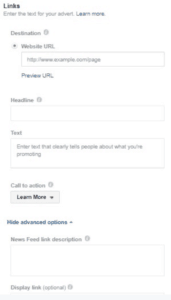
Step 4. Create your welcome screen with headline, content and CTA.
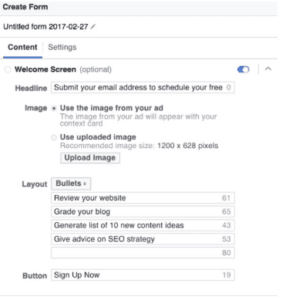
Step 5. Specify your form fields and add any optional questions you need.
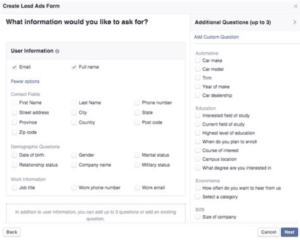

Step 6. Add a privacy policy and legal disclaimers. Facebook can provide an auto disclaimer but you must provide your own privacy policy.
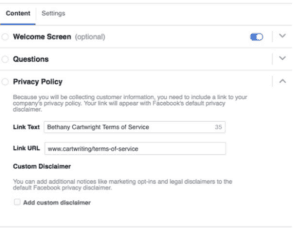
Step 7. Add your thank you screen and then the ad is complete, so click save and place your ad order.
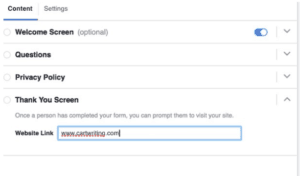
Specs
The visual and text specs are the same as a standard or carousel or video ad, depending on your choice.
The recommended image size for the form and welcome screen is 1,200 x 628 pixels.
Your welcome screen headline can be 60 characters and your welcome screen button 30 characters.
Your welcome screen main text has no set character limit when in paragraph format but we recommend keeping it short. If you choose bullet points the character limit is 80 per point.
You must include a privacy policy and website URL link.

Final thoughts
With these templates and strategies in your arsenal you can now launch a profitable Facebook campaign.
Remember, no matter which Facebook objective you choose, it is a good idea to set up a tracking pixel before you begin. With one pixel on your website you can set multiple event types as conversions in Facebook Ads Manager and apply them to any campaign you wish. Read our blog on How to Set up Facebook Ads for Maximum Conversions for full instructions on adding your pixel and setting conversion events.
